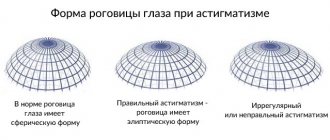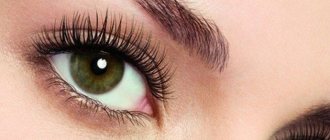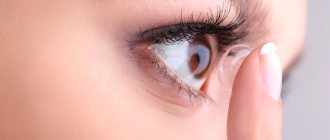The lens is inside out
This is the most common case. Why is this happening? Most often this happens due to improper removal, when a person turns the lens out in the evening and places it in the same form in a special container overnight. Then in the morning, without hesitation, he puts it on as usual.
How can you tell if a lens is on the right side or is it inside out? To do this, you need to place it on your finger and carefully examine it. Even if the lens has a convex shape, its edges may be slightly concave inward. This means it's turned inside out. Also, when you place the lens on your finger, you can see barely noticeable numbers on it. They may be different for different manufacturers. If the product is positioned correctly, then the numbers will be turned towards the person with the right side (readable), otherwise they will be inside out. This is created by manufacturers specifically for such cases when there are doubts about the coating before putting it on.
Such cases are most typical for modern products made from hydrogel material. These optical correction devices are thinner, and therefore the likelihood of them being everted is much higher.
Why is this happening?
Despite all the advantages, people often refuse to wear lenses when buying glasses because they are easier to handle.
Indeed, for many, a significant problem is the process of removing lenses, which can take from several minutes to an hour. In some cases, you have to consult a doctor because a person cannot remove the lens on his own. Difficulties arise due to neglect of the rules of care, violation of the technique of use. All of the above factors are easily correctable. Therefore, if problems arise with lens removal, it is necessary to identify the root cause and eliminate it. A qualified specialist will help you do this.
Main reasons:
- Adaptation period. Using lenses requires some skill. On average, the addiction process takes from several days to two weeks. During this period, it may feel as if the lens is stuck to the eye and cannot be removed. To avoid such a problem, you need to undergo detailed instructions from an ophthalmologist before purchasing. It is not enough to just tell how to remove and put on lenses; you need to teach a person how to do it right in the office. The procedure may need to be repeated several times until the patient masters the skill.
- Excessive dryness of the eye. Sitting at a computer for a long time, using air conditioning, and tobacco smoke affect the production of natural eye secretions. The cornea becomes dry. The lens fits very tightly to the eye, it becomes difficult to move it. In this case, the use of artificial tears is indicated.
- Incorrect position. The lens should normally be located in the center of the cornea, but sometimes it moves to the side, upward. In such cases, it becomes more difficult to remove it. The main task is to return the lens to its original position or try to move it to the corner of the eye.
- Wet hands. Before the procedure, you need to wash and then dry your hands. It is difficult to grasp the lens with wet fingers; your hands will simply slide over its surface.
- Untimely withdrawal. If the lens feels as if it is stuck in the eye, it may not have been removed for a long time. It is necessary to adhere to the recommendations of the ophthalmologist, give your eyes a rest at night, and change the solution on time. Read more about what will happen if you don’t remove your lenses for a long time →
Before removing the lens, you need to make sure that it is in the eye. It is recommended to stand in front of a mirror in a well-lit room, look up and to the sides, trying to detect its edges.
Incorrectly selected optics or defective
What does the expression “incorrectly selected optics” mean? First of all, lenses are selected in accordance with characteristics such as diopters, which reflect the ability of the product to correct existing myopic disorders. But if you carefully read the characteristics, you can also see such factors as “lens diameter”, “base curvature”. Usually these parameters have very similar sizes even from completely different manufacturers. But each person is individual, which means that the size of the eyeball may also differ. This affects the ability of the contact lens to attach. If this is the reason for regular lens displacement, then it is necessary to make a choice based on these characteristics.
The same can be said about products that have irregularities in shape, when the lens does not stick to the eye completely over the entire surface. Such optical correction products will not adhere to the surface of the eye, and therefore will not bring benefit to their owner. Moreover, thanks to such products, visual acuity can only worsen, because a displaced lens implies a displacement of its center, which ideally should fit exactly near the pupil, and this leads to overstrain of the eye muscles. If a person is faced with a manufacturing defect, then you can contact the optician where you purchased the product to replace it or return it. Usually sellers and manufacturers themselves are willing to make such concessions, because reputation and every client are important to them.
Incorrect selection as a cause of lenses slipping
Contact optics are selected based on several parameters. One of them is the radius of base curvature (BC). It represents the shape or curvature of the inner surface of an ophthalmic product and should match the curvature of the cornea. Standard values for this indicator are in the range from 7.8 to 9.5 mm. When selecting lenses, the difference between the curvature of the cornea and the radius of the product cannot exceed 0.2 mm. If the product is too small, it compresses the eye, which leads to hypoxia - oxygen starvation. If BC is greater than the corneal curvature, the lens slips off the pupillary area. As a result, the correction is of poor quality. In addition, lacrimation occurs.
The radius of curvature is measured using medical equipment. This means that lenses are selected only with an ophthalmologist. It is necessary to undergo an examination, during which visual acuity is checked, eye parameters are measured, contraindications are identified, and disposable optics are tried on. Also, a person learns to handle it. He will put on the lenses for 20-30 minutes and tell the doctor about his feelings, the presence or absence of discomfort. After this, a prescription will be issued with which you can make a purchase.
Rules of care violated
There are several mistakes when using contact lenses that can affect their quality:
- Failure to follow simple hygiene rules. Contact correction devices must not be touched with dirty hands. Even small particles of dust and dirt on your fingers can cause microcracks to appear on the surface of the product in the future. This will degrade the properties of the lens. The same can be said about cosmetics. Makeup should be applied after the lenses are inserted, although some experienced users can perform the procedure carefully even with makeup on their eyes.
- Drying. Failure to fully fill the storage container with the special solution may result in the lens material being damaged. Even one-time overdrying can lead to such a disastrous outcome. It is also necessary to comply with the purpose of the solution. Thus, products for soft products cannot be used for models made of hard products, and vice versa.
- Reuse of solution. Most likely, a person does this in order to save money, but it turns out to be imaginary. A used solution no longer has the properties it should have (for example, disinfecting and cleaning). It may already contain pathogens that will later transfer to the surface of the contact lens. It wears out much faster and becomes unable to maintain its properties (including elasticity or breathability) for the time stated by the manufacturer.
- Use of expired products. It’s not for nothing that manufacturers indicate the expiration date, because it can only be determined experimentally. In other words, the products are pre-tested, and only within a certain time after opening the package, the manufacturer guarantees the therapeutic effect stated in the annotation. After a certain date, contact lenses not only become useless, but can also harm vision, with which a person already has problems.
What can't you do?
Some manipulations can lead to injury to the cornea, vascular hemorrhages, and irritation of the mucous membrane. It is prohibited to use improvised means to remove the lens. Tweezers, cotton swabs, and matches damage the eye. All actions must be carried out using your fingertips. Do not move the lens by trying to grab it with your fingernails.
Under no circumstances try to remove the lens by squeezing it with long nails (especially for girls); this should only be done with the pads of your fingers. Otherwise, you risk scratching not only the optical device itself, but also your visual organs, as well as causing an infection.
Operate only with clean and dry hands. Dry them with a lint-free towel. Make sure that there are no small lint on your hands that can cause harm.
We suggest you familiarize yourself with Headache in the left eye area
Do not try to remove the contact correction device with tweezers or other sharp objects. This can damage your visual organs.
If the lens is stuck to your finger
The situation when the lens sticks to the finger and thereby interferes with its installation in the eye socket is usually encountered by those who are just getting used to wearing contact optical correction devices. When putting on the lens, the outer surface may stick to your finger. If this happens, you should not tear your finger off the material of the product, as this can damage it. You need to apply a few drops directly to the lens (concave side), but your finger remains dry. Now you need to try to slightly detach the lens with soft, delicate movements. The advice to blink a few times also helps. After this, the product will detach from the skin of the fingers and attach more tightly to the surface of the eyeball.
Expert advice
Before the lens removal procedure, you should always moisturize your eyes with a solution. After this, dry your fingers and remove the lens. Before instillation, be sure to read the instructions that come with the package.
If you experience even the slightest feeling of discomfort in your eyes before going to bed, do not go to bed, as the next morning they will be completely dry, which can lead to infection. If the cornea remains red and irritated even after removing ophthalmic products, we strongly recommend that you consult a qualified ophthalmologist. Most likely, you accidentally scratched your eyeballs.
Take care of your eyes!
What deviations from the base curvature are acceptable?
Patients often have questions about how minor deviations from the norm are acceptable when choosing curvature, for example, from a radius of 8.5 to a radius of 8.6, etc. A slight error in the larger direction will not harm your eyes, and in practice you will hardly feel it this. In this case, it is recommended to remove your lenses while swimming in the pool or use special safety glasses.
With a very large radius, the lens begins to “float” on the eye, which makes its use not very pleasant and worsens vision. In such a situation, it is recommended to consult a doctor and replace the products.
In the online store Lenzy.ru you can buy high-quality lenses at a competitive price. We wish you successful purchases!
How to use lenses so they don't stick
Any unpleasant situation can be avoided. Everything depends only on the person’s discipline and desire to maintain health. You may never know about the problem of a lens sticking to the eyeball if you follow a few simple rules when handling these contact devices:
- never wear lenses beyond the prescribed period;
- if from time to time you begin to feel dry eyes, use drops to moisturize the microliters in time;
- Do not sleep in lenses that are prohibited for sleeping with. Also, remove your continuous wear lenses from time to time at night.
- If you notice that while wearing the microscope there is discomfort, itching, watering, the picture has become cloudy - consult an ophthalmologist, do not ignore these symptoms.
Preventive measures
To avoid any questions about what to do if the lens is tightly stuck to the eye, you must follow several rules.
By following these simple recommendations, you can avoid dry eyes, infection, and problems with removing lenses:
- Before the procedure, you need to wash your hands with soap. Wet wipes and plain water do not clean your fingers well enough. It is recommended to use a liquid product.
- Alcohol antiseptic solutions can cause irritation and burns of the mucous membrane.
- Hands must be dry. The best option is to use hand dryers. Paper napkins will also work. It is better to refuse terry towels. Flint often remains on the fingers and gets into the eyes, causing irritation.
- Lens solution must be changed every day and should not be reused.
- It is better to start putting on and removing lenses from one eye. This will help avoid mixing up the containers.
- Before purchasing lenses, you should consult an ophthalmologist. The doctor should teach you how to use them and tell you about the features of care.
- You need to adhere to the regime of wearing lenses - remove them at night, carry out scheduled replacement.
- If work involves spending a long time at computers, the mucous membranes of the eyes may dry out. In this case, the doctor prescribes additional moisturizing products - artificial tears.
- It is recommended to stop smoking - tobacco smoke has a negative effect on the mucous membranes of the eyes.
- Regular visits to an ophthalmologist will help to identify and prevent vision problems in a timely manner. A preventive examination is carried out at least once a year.
- If your vision begins to deteriorate, redness, pain in the eye area, or a sensation of a foreign body occur, you should not postpone a visit to the doctor.
To prevent the lens removal process from taking several tens of minutes, you need to follow simple recommendations. Using moisturizing drops, quitting smoking, and maintaining good hygiene allow you to forget about this problem. It is equally important to find a good ophthalmologist who will conduct an examination, choose lenses, and teach you how to use them.
Algorithm of actions: how to put on lenses for the first time
Before putting it on, you first need to install a two-way mirror on the table in a bright room to increase your view. Place a container with lenses, moisturizing eye drops, saline solution without preservatives and a remover nearby.
Algorithm of actions:
- Wash your hands thoroughly with antibacterial soap (preferably), dry them with a lint-free towel (you can use a waffle one). Disposable napkins, towels or terry cloth are not suitable due to the presence of lint. Their microparticles can get into the eyes and become a source of infection.
- Train yourself to always start the procedure with one specific eye so as not to get confused. To do this, you can make the cells colored or label them.
- Remove the lens from the solution with tweezers and rinse with the solution.
- Place the contact lens on the tip of your index finger - you need to inspect it for defects and inversion. If it stands correctly, it has the shape of a bowl, if turned inside out, it has the shape of an inverted plate.
- With the same hand, but with the middle finger, slightly pull the lower eyelid down.
- Use the finger of your other hand to lift the upper eyelid up. When applying, look up or to the side so that the eye does not close when the lens approaches.
- With the palpebral fissure open, place the lens downwards on the eyeball, not in the center. It will then be placed under the lower eyelid. When touched, there should be a sensation of the lens “floating”.
- Look down, put the eyelid back in place, remove your fingers.
- Ready. All that remains is to slowly close your eyes and move them to the sides. Then the lens will install itself correctly and the fit to the eyeball will become tight.
- Correct installation will show improved vision.
- Repeat all the steps above with the other eye.
Below are 2 more schemes for putting on CL to choose from.
Scheme No. 1:
- Wash your hands thoroughly.
- Remove the lens and rinse it with fresh saline solution.
- Place the CL between the index, middle and thumb like a cup.
- Fill the lens to the brim with physical. solution. Additional rinsing will make it easier to fix.
- Now looking into the mirror lying horizontally on the table, press your chin to your chest.
- Open the palpebral fissure as wide as possible. To do this, you need to fix the upper and lower eyelids.
- There should be no bubbles under the lens. Otherwise your vision will be blurry.
- Further actions are similar to the first scheme.











